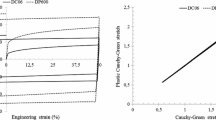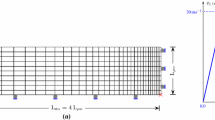Abstract
In this work, a large strain one-dimensional GTN ductile damage model accounting for thermal effects and mixed hardening is developed. The Lagrangian constitutive framework is based on the Kroner–Lee decomposition together with thermodynamic principles. The damage evolution is described in terms of the porosity rate. The yield function follows the usual GTN criterion, condensed according to the uniaxial stress state. Mixed hardening behavior is expressed combing the Swift isotropic model with the Armstrong–Frederick rule for kinematic hardening. Plastic work heating is also included in terms of temperature rate. The formulation developed is implemented in a 3D truss bar finite element code. Elastic predictor and plastic correction are adopted together with time integration of the inelastic variables. The consistent tangent operator is also provided and used in the numerical algorithm. Results illustrate the performance of the proposed formulation in predicting the large-strain behavior of truss bar problems regarding the evolution of forces, stresses, strains, porosity, isotropic hardening parameter, temperature and backstress. The influence of the set of plastic parameters is investigated in detail, considering four steels. The present formulation is also compared to the corresponding isothermal, undamaged and perfectly plastic situations, highlighting the importance of using the full model.




















Similar content being viewed by others
References
Driemeier L, Proenca SPB, Alves M (2005) A contribution to the numerical nonlinear analysis of three-dimensional truss systems considering large strains, damage and plasticity. Commun Nonlinear Sci Numer Simul 10:515–535
Malla RB, Agarwal P, Ahmad R (2011) Dynamic analysis methodology for progressive failure of truss structures considering inelastic postbuckling cyclic member behavior. Eng Struct 33:1503–1513
Gurson AL (1977) Continuum theory of ductile rupture by void nucleation and growth: Part i–yield criteria and flow rules for porous ductile media
Tvergaard V, Needleman A (1984) Analysis of the cup-cone fracture in a round tensile bar. Acta Metall 32:157–169
Thomson R, Hancock J (1984) Ductile failure by void nucleation, growth and coalescence. Int J Fract 26:99–112
Pang W-W, Zhang P, Zhang G-C, Xu A-G, Zhao X-G (2014) Dislocation creation and void nucleation in fcc ductile metals under tensile loading: a general microscopic picture. Sci Rep 4:1–7
Suzuki J, Muñoz-Rojas P (2014) Transient analysis of geometrically non-linear trusses considering coupled plasticity and damage, in: Tenth World Congress on Computational Mechanics, volume 1, Citeseer, p 98
Carniel T, Muñoz-Rojas P, Vaz M Jr (2015) A viscoelastic viscoplastic constitutive model including mechanical degradation: uniaxial transient finite element formulation at finite strains and application to space truss structures. Appl Math Model 39:1725–1739
Felipe TR, Leonel ED, Haach VG, Beck AT (2019) A comprehensive ductile damage model for 3d truss structures. Int J Non-Linear Mech 112:13–24
Li K, Carden W, Wagoner R (2002) Simulation of springback. Int J Mech Sci 44:103–122
Oliveira M, Alves J, Chaparro B, Menezes L (2007) Study on the influence of work-hardening modeling in springback prediction. Int J Plast 23:516–543
Milligan R, Koo W, Davidson T (1966) The bauschinger effect in a high-strength steel
Dettmer W, Reese S (2004) On the theoretical and numerical modelling of armstrong-frederick kinematic hardening in the finite strain regime. Comput Methods Appl Mech Eng 193:87–116
Manda A, Nakamura S (2010) Progressive collapse analysis of steel truss bridges. Strain 2:2–850
Miyachi K, Nakamura S, Manda A (2012) Progressive collapse analysis of steel truss bridges and evaluation of ductility. J Constr Steel Res 78:192–200
Felipe TR, Beck AT (2021) Dynamic analysis of failure paths of truss structures: Benchmark examples including material degradation. Mech Syst Signal Process 158:107767
Yan J, Yang S, Yang C (2014) Multiscale analysis of thermal stress of lattice materials and its size effects. J Therm Stress 37:885–904
Zhang H, Wu J, Fu Z (2010) Extended multiscale finite element method for elasto-plastic analysis of 2d periodic lattice truss materials. Comput Mech 45:623–635
Zhang H, Wu J, Zheng Y (2012) An adaptive multiscale method for strain localization analysis of 2d periodic lattice truss materials. Philosop Mag 92:3723–3752
Zhang C, Akbarzadeh A, Kang W, Wang J, Mirabolghasemi A (2018) Nano-architected metamaterials: carbon nanotube-based nanotrusses. Carbon 131:38–46
Liu F, Zhu Z, Li X, Xu J (2019) Study on thermal stability and bifurcation analysis of fcc carbon nanotube-based nanolattice as hydrogen storage materials. Int J Hydrog Energy 44:29597–29603
Ghaderi A, Ghavanloo E, Fazelzadeh S (2021) Reliability analysis of carbon nanotube-based nano-truss under various loading conditions,. Iran J Sci Technol Trans Mech Eng 45:1123–1131
Allen DH (1985) A prediction of heat generation in a thermoviscoplastic uniaxial bar. Int J Solids Struct 21:325–342
Cvetkovski K, Ahlström J, Karlsson B (2010) Thermal softening of fine pearlitic steel and its effect on the fatigue behaviour. Procedia Eng 2:541–545
Allen DH (1986) Predicted axial temperature gradient in a viscoplastic uniaxial bar due to thermomechanical coupling. Int J Numer Methods Eng 23:903–917
Vladimirov IN, Pietryga MP, Reese S (2008) On the modelling of non-linear kinematic hardening at finite strains with application to springback-comparison of time integration algorithms. Int J Numer Methods Eng 75:1–28
Pascon JP (2016) Nonlinear analysis of hyperelastoplastic truss-like structures. Arch Appl Mech 86:831–851
Hao S, Brocks W (1997) The gurson-tvergaard-needleman-model for rate and temperature-dependent materials with isotropic and kinematic hardening. Comput Mech 20:34–40
Vladimirov I, Pietryga M, Reese S (2009) Prediction of springback in sheet forming by a new finite strain model with nonlinear kinematic and isotropic hardening. J Mater Process Technol 209:4062–4075
Pascon JP (2012) Sobre modelos constitutivos não lineares para materiais com gradação funcional exibindo grandes deformações: implementação numérica em formulação não linear geométrica, Ph.D. thesis, Universidade de São Paulo
Kröner E (1959) Allgemeine kontinuumstheorie der versetzungen und eigenspannungen. Arch Ration Mech Anal 4:273–334
Lee EH (1969) Elastic-plastic deformation at finite strains
McAuliffe C, Waisman H (2015) A unified model for metal failure capturing shear banding and fracture. Int J Plast 65:131–151
Lubarda VA (2004) Constitutive theories based on the multiplicative decomposition of deformation gradient: thermoelasticity, elastoplasticity, and biomechanics. Appl Mech Rev 57:95–108
Tvergaard V (1982) On localization in ductile materials containing spherical voids. Int J Fract 18:237–252
Swift W (1947) Length changes in metals under torsional overstrain. Engineering 163:253
Chu C, Needleman A (1980) Void nucleation effects in biaxially stretched sheets. J Eng Mater Technol 102:249–256
Needleman A, Tvergaard V (1991) An analysis of dynamic, ductile crack growth in a double edge cracked specimen. Int J Fract 49:41–67
Pascon JP, Waisman H (2021) A thermodynamic framework to predict ductile damage in thermoviscoplastic porous metals. Mech Mater 153:103701
Armstrong PJ, Frederick C (1966) A mathematical representation of the multiaxial Bauschinger effect, volume 731, Central Electricity Generating Board [and] Berkeley Nuclear Laboratories ...
Flores P, Duchene L, Bouffioux C, Lelotte T, Henrard C, Pernin N, Van Bael A, He S, Duflou J, Habraken A (2007) Model identification and fe simulations: effect of different yield loci and hardening laws in sheet forming. Int J Plast 23:420–449
Xue Z, Faleskog J, Hutchinson JW (2013) Tension-torsion fracture experiments-part ii: simulations with the extended gurson model and a ductile fracture criterion based on plastic strain. Int J Solids Struct 50:4258–4269
Kiran R, Khandelwal K (2014) Gurson model parameters for ductile fracture simulation in astm a992 steels. Fatigue Fract Eng Mater Struct 37:171–183
Zhou J, Gao X, Sobotka JC, Webler BA, Cockeram BV (2014) On the extension of the gurson-type porous plasticity models for prediction of ductile fracture under shear-dominated conditions. Int J Solids Struct 51:3273–3291
Besson J (2009) Damage of ductile materials deforming under multiple plastic or viscoplastic mechanisms. Int J Plast 25:2204–2221
Besson J (2010) Continuum models of ductile fracture: a review. Int J Damage Mech 19:3–52
De Freitas J, Ribeiro A (1992) Large displacement elastoplastic analysis of space trusses. Comput Struct 44:1007–1016
Blandford GE (1996) Large deformation analysis of inelastic space truss structures. J Struct Eng 122:407–415
Blandford GE (1997) Review of progressive failure analyses for truss structures. J Struct Eng 123:122–129
Krishnamoorthy C, Ramesh G, Dinesh K (1996) Post-buckling analysis of structures by three-parameter constrained solution techniques. Finite Elements Anal Des 22:109–142
Greco M, Gesualdo F, Venturini W, Coda H (2006) Nonlinear positional formulation for space truss analysis. Finite Elements Anal Des 42:1079–1086
Acknowledgements
The author appreciates all the support provided by Fundação de Amparo à Pesquisa do Estado de São Paulo (FAPESP).
Author information
Authors and Affiliations
Corresponding author
Ethics declarations
Conflict of interest
The author declares that there is no conflict of interest regarding the present work.
Additional information
Technical Editor: João Marciano Laredo dos Reis.
Publisher's Note
Springer Nature remains neutral with regard to jurisdictional claims in published maps and institutional affiliations.
Rights and permissions
About this article
Cite this article
Pascon, J.P. A large strain one-dimensional ductile damage model for space truss analysis considering Gurson’s porous plasticity, thermal effects and mixed hardening. J Braz. Soc. Mech. Sci. Eng. 44, 186 (2022). https://doi.org/10.1007/s40430-022-03490-2
Received:
Accepted:
Published:
DOI: https://doi.org/10.1007/s40430-022-03490-2




